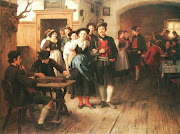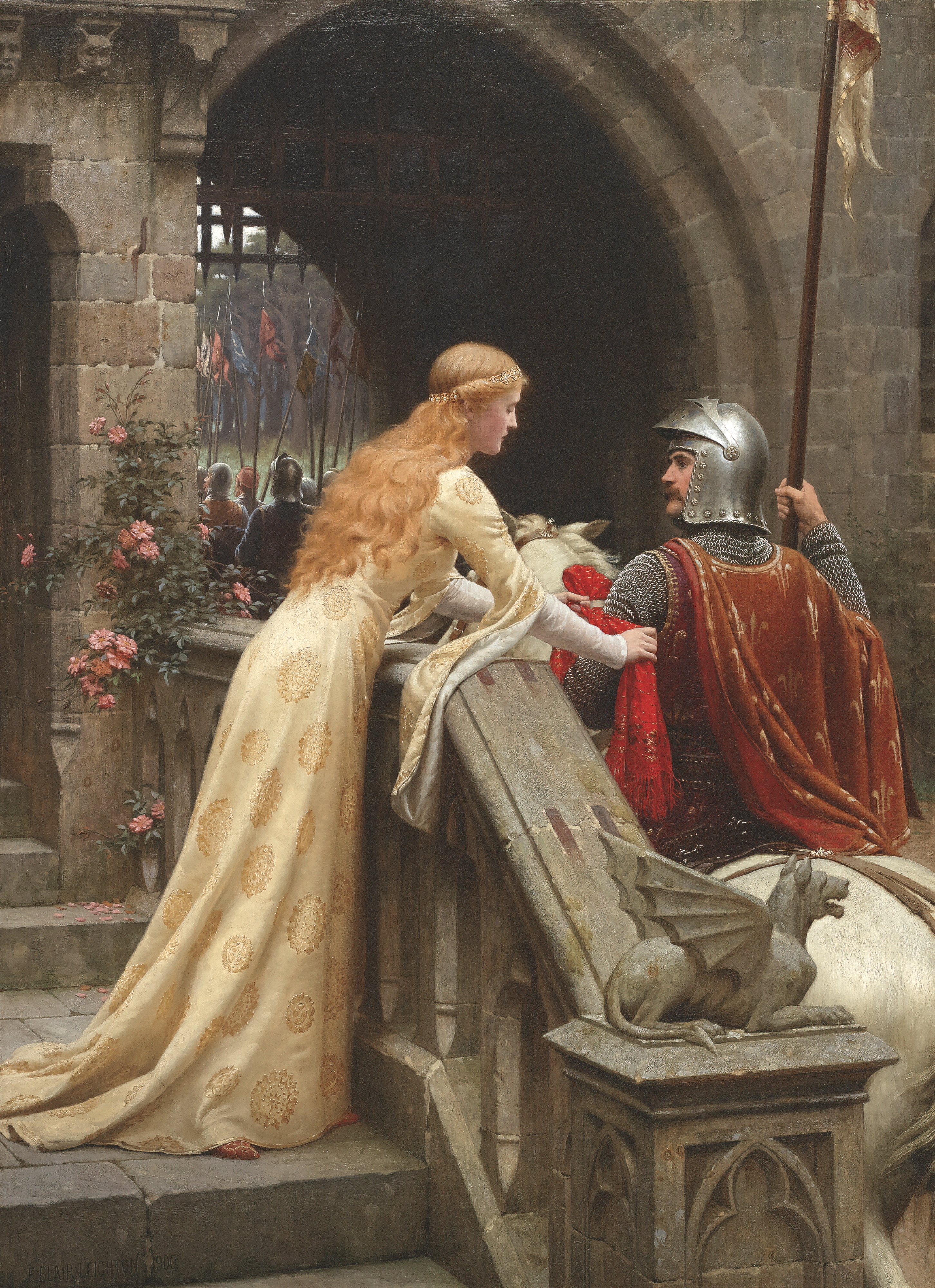Walk upon England's mountains green?
And was the Holy Lamb of God,
On England's pleasant pastures seen?
And did the Countenance Divine,
Shine forth upon our clouded hills..."
So wrote William Blake, the slightly eccentric poet and alleged "mystic" of English literature but with more than a grain of truth in his musings.
Did our Lord and St Joseph of Arimathaea, the Jewish Christian member of the Sanhedrin who later buried our Lord, come to Glastonbury, called the Isle of Avalon (meaning "apples"), as the legends of King Arthur and other stories would have us believe?
Since we know that St Mary Magdalene, St Mary the mother of James and John, and St Mary the mother of Salome, together with St Lazarus found their way to the coast of France near Marseilles and that St Lazarus became the first bishop, it is by no means impossible that St Joseph of Arimathaea came to Britain. Certainly, there is evidence of a Roman jetty on the side of Wirral (“Weary-all”) Hill and the Phoenicians traded with Britain.
St Thomas, let us not forget, went to Persia and India and founded the Syriac Churches who, to this day, use Aramaic, the spoken language of our Lord, in their sacred liturgy.
Legend has it that St Joseph brought with him the Holy Grail used at the Last Supper but also used later to collect the Holy Blood of Christ (later called the Sang Real or San Greal by Malory, meaning either “Royal Blood” or “Holy Grail”) which then gave rise to the Grail Legends in which King Arthur’s Knights of the Round Table went in search of the Grail but only Sir Galahad, the pure and holy knight, was able to find it.
King Arthur was a Romano-British knight who, after the Roman Legions had withdrawn, was compelled to become a chief of the remaining British Christians. That he was called “king” need not surprise us since the idea of the Roman Empire, the Emperor and of kings, was then well-established in Christian theology and politics. Let us not forget that the Emperor Constantine was declared Emperor at York by his army over 100 years before. Imperial and Royal ideas were the norm, as was Roman Catholic Christianity and Roman Christendom.
The Grail legends have a sub-stratum of truth for all that later writers have much embroidered them and they have exercised a great influence in British political and literary history.
The longest Abbey in England was built at Glastonbury and within it was incorporated the original "wattle and daub" oratory of St Joseph. The Abbey enjoyed the highest royal favour until the Protestant Reformation when King Henry VIII's Commissioners sacked and pillaged it and caused the last Abbot, Blessed Richard Whiting OSB, to be hanged from the tower of St Michael's Church upon the Tor. Now only the tower remains on the Tor and can be visited to this day.
Here is a good summary of the Glastonbury Legend:
“It is at Glastonbury that legend takes upon itself to go up not only to the beginnings of British Christianity, but also to the beginnings of Christianity itself. The legends of the spot go back to the days of the Apostles. The place is indeed unique, for from the very beginnings of Christianity it was hallowed ground. A legend even tells us that Christ himself as a boy walked upon the hills of Somerset…There is, in any case, more than enough of proved history to shew that Glastonbury was for centuries the most ancient and famous centre of Christianity in the land.
For example, the legend of St Joseph of Arimathaea coming to England is of ancient date, and there is also that others lovely tradition that Christ himself in his boyhood came hither. Though improbable it is not impossible, for we know that the Phoenicians came to Britain seeking metals, several centuries before the Christian era. Herodotus, in the fifth century BC, speaks of Cornwall as the Tin Islands, and Greeks too came in search of ore. St Joseph may conceivably have been one of those merchants and have acquired his wealth thus, in which case he might have brought the Holy Child with him on one of his journeys. If he had had this former acquaintance with our island, it would account for Joseph's being chosen as a missionary to Britain by St Philip. Such traditions are stories to cherish…
About the middle of the thirteenth century the traditions concerning the coming of St Joseph of Arimathaea to Glastonbury were written down as an introduction to William of Malmesbury's work On the Antiquity of the Church of Glastonbury. We learn from these traditions that the Apostle St Philip sent Joseph of Arimathaea from Gaul with twelve companions to bring the gospel message to our ancestors. This cultivated and wealthy Jew left his home and possessions and all that he had, and now, a poor man, bearing with him the priceless treasures of the true faith and a relic of the Holy Blood, he braved the long and perilous journey which brought him in AD 63 to the shores of Wales and thence travelled across the inland sea [Severn Sea or Bristol Channel] and marshy ground [Somerset Levels] to the Isle of Avalon...
John of Glastonbury relates this story and adds that Joseph and his son Josephes were disciples of St Philip by whom they were baptised. While St John was at Ephesus St Joseph remained with our Blessed Lady and was present at her Assumption. Fourteen years later he went to St Philip in Gaul whither that Apostle had been sent after the Ascension, as Freculfus, bishop of Lisieux states. Josephes, whom the Lord had consecrated bishop in Sarath went with him. Then the Apostle sent twelve of his disciples to preach the faith in Britain and he placed at their head St Joseph and his son Josephes…The pagan king Arviragus to whom they came rejected their teaching but gave them the island Ynyswitrin, or Glassy Isle, now called Glastonbury. He and two other kings subsequently gave them a further grant of lands known as the 'twelve hides' [one hide = 160 acres]. The legend says that St Joseph brought with him two cruets in which some of the sacred blood and the water which flowed from the wounds of our Blessed Lord was miraculously preserved.
'Avallon is entered by a band of Twelve:
Joseph, Arimathaea's flower, is chief of them;
And with his father cometh Josephes.
So to these Twelve Glastonia's rights are given.
In Pynson's Life of Joseph of Arimathaea we read:
And when our lorde in the sedony was drest
This blood in two cruettes Joseph did take.'
...At Weary-all Hill he and his companions rested, gazing down upon the valley where, at the foot of the Tor close by, he built what was probably the first Christian church above the ground that was ever raised. A later tradition also says that while resting he thrust his pilgrim's staff into the soil, and forthwith it budded, and a fair tree grew and flourished, and blossomed twice in the year. In the Life of Joseph of Arimathaea printed by Richard Pyerson or Pynson, the pupil of Caxton, in 1520, we read:
'The hawthornes also that groweth in Wirral
Do burge and bere greene leaves at Christmas
As freshe as other yn May...'
The holy thorn was cut down in 1653 by a zealous Puritan, but many slips [shoots] of it had been budded and its descendants still 'blossom at Christmas, mindful of our Lord'.
The Archangel Gabriel appeared to St Joseph and bade him build a church in honour of our Lady's Assumption:
'So Joseph dyd as the angell hym bad,
And wrought there an ymage of our lady;
For to serve hyr great devotion he had;
And that same ymage is yet at Glastonbury,
In the same church; there ye may it se.
For it was the fyrst, as I understande,
That ever was sene in this countre;
For Joseph it made wyth his owne hande. '
Thus did the first Apostle of Britain and his disciples make a little oratory 'of twisted twigs' to praise God at the foot of St Michael's Tor; it was 60ft long and 26ft wide, and from that wattle church dedicated to His Blessed Mother by our Lord Himself, they and their successors scattered far and wide the seed of the true faith, to north and south, to east and west; and like the seed of mustard it grew to a great tree whose branches spread over north-west Europe. In Tennyson's Holy Grail the monk Ambrosius tells Perceval that:
'From our old books I know
That Joseph came of old to Glastonbury,
And there the heathen prince, Arviragus,
Gave him an isle of marsh whereon to build;
And there he built with wattles from the marsh
A little lonely church in days of yore.
For so they say, these books of ours.'
It is said that the once-wealthy Jew, the 'friend of Pilate and of the Lord', who had given the sumptuous sepulchre he had prepared for himself to Him Who had no place to lay his Head, slept his last sleep in the shadow of the poor and primitive church of reeds at Avalon, the first of those innumerable saints whose bodies have sanctified this soil.
John of Glastonbury quoting a prophecy of the British bard Melkin, says that in Avalon's Island Joseph...
'Hath found perpetual sleep;
And he lies on a two-forked line
Next the south corner of an oratory
Fashioned of wattles
For the adoring of a mighty Virgin
By the aforesaid sphere-betokened
Dwellers in that place, thirteen in all. ..'
His [Joseph's] feast was formerly kept on July 27th and great was the concourse of pilgrims who flocked to pray before his statue. William Good, born at Glastonbury in 1527 and who, a member of the Society of Jesus [Jesuits], died at Naples in 1596, says that in a long subterranean chapel there was a most famous place of pilgrimage 'which was made to a stone image of St Joseph there and many miracles were wrought at it. When I was a boy of eight, for I was born there, I have served Mass in this chapel, and I saw it destroyed in the time of Henry VIII...' "






.jpg)

















_-002.jpg/220px-Circle_of_Anton_Raphael_Mengs,_Henry_Benedict_Maria_Clement_Stuart,_Cardinal_York_(ca_1750)_-002.jpg)


No comments:
Post a Comment